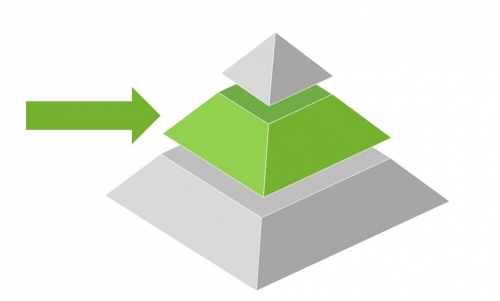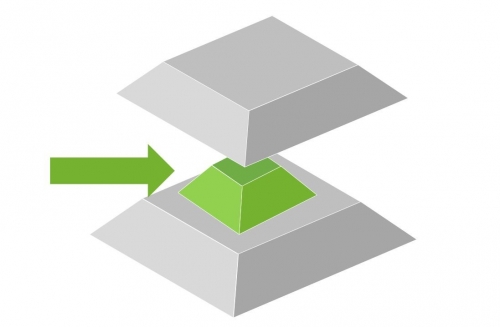Mid-Level Giving And Your Target Analytics Data
Published
Mid-Level Giving and Your Target Analytics Data
I am very excited about the blog series I am launching here in the Target Analytics Community over the coming months in regards to how our nonprofit clients can utilize modeling and wealth append/screening data from Target Analytics to help identify prospects for mid-level giving.
Let’s talk about mid-level giving – that often elusive middle part of the pyramid – that can be difficult to grow in terms of dollars raised. It can even be difficult for our organizations to truly define what dollar range represents mid-level giving. Many of the organizations that we work with define their 12-month mid-giving level to start at around $500, and I’ve seen it go as high as $25,000 or even $50,000. The actual range varies by organization, so you will have to adjust some recommendations in this blog and the upcoming blogs based on your institution’s specific definition.
First, we need to do a reality check at our organizations. We often think of our mid-level group as truly fleshing out in a pyramid shape in comparison to the major gift and annual gift programs in terms to how much money is raised from each area of giving. It may pan out to look like the graphic below in terms of the number of prospects and donors at the various annual, mid-level, and major gift levels, but we sometimes don’t see the dollars raised for each program fleshing out like a pyramid.

In reality some nonprofits often have a large amount raised from major gift donors and a large base of dollars raised at the lower annual fund level, but smaller dollars raised at the mid-level in comparison to the dollars raised from the other two groups. And even though it isn’t always the case, you might find that your pyramid actually looks like the graphic below – where dollars raised from each level of giving appearing to be in the shape of an anvil vs. a pyramid

I hope to provide ideas on utilizing data results from your TA projects to identify the best prospects to bridge the gap between annual fund and major gifts and also discuss why it’s important for you organization to do this. It’s important to remember that in addition to growing the pool of dollars raised by mid-level donors, with proper and intentional cultivation and stewardship, many of these mid-level prospects may turn out to be emerging major gift donors. Mid-level prospects deserve a more customized and distinct engagement strategy from the annual fund, and we’ll discuss ways your organization can segment out these prospects as well as various personalized strategies you can employ in lieu of assigning them to a major gift officer.
As I post content on this subject via a series of blogs in the coming months, my hope is that our TA clients will chime in on content they’d like to see. At the end of my blogging series on this topic, I will develop a concise resource document on utilizing your analytics for mid-level giving. I also plan to share a case study or two on the subject. So whether you have our ProspectPoint predictive models with AGL, MidGL, MGL and TGR scores, etc. and/or Affluence Insights and WealthPoint public research data within ResearchPoint, I plan to discuss ways of identifying and prioritizing prospects based on all these various services.
In conclusion for this blog, please take a moment to let me know your initial ideas and questions that you’d like to see represented and/or answered over the coming months and eventually in the upcoming resource document.
I am very excited about the blog series I am launching here in the Target Analytics Community over the coming months in regards to how our nonprofit clients can utilize modeling and wealth append/screening data from Target Analytics to help identify prospects for mid-level giving.
Let’s talk about mid-level giving – that often elusive middle part of the pyramid – that can be difficult to grow in terms of dollars raised. It can even be difficult for our organizations to truly define what dollar range represents mid-level giving. Many of the organizations that we work with define their 12-month mid-giving level to start at around $500, and I’ve seen it go as high as $25,000 or even $50,000. The actual range varies by organization, so you will have to adjust some recommendations in this blog and the upcoming blogs based on your institution’s specific definition.
First, we need to do a reality check at our organizations. We often think of our mid-level group as truly fleshing out in a pyramid shape in comparison to the major gift and annual gift programs in terms to how much money is raised from each area of giving. It may pan out to look like the graphic below in terms of the number of prospects and donors at the various annual, mid-level, and major gift levels, but we sometimes don’t see the dollars raised for each program fleshing out like a pyramid.

In reality some nonprofits often have a large amount raised from major gift donors and a large base of dollars raised at the lower annual fund level, but smaller dollars raised at the mid-level in comparison to the dollars raised from the other two groups. And even though it isn’t always the case, you might find that your pyramid actually looks like the graphic below – where dollars raised from each level of giving appearing to be in the shape of an anvil vs. a pyramid

I hope to provide ideas on utilizing data results from your TA projects to identify the best prospects to bridge the gap between annual fund and major gifts and also discuss why it’s important for you organization to do this. It’s important to remember that in addition to growing the pool of dollars raised by mid-level donors, with proper and intentional cultivation and stewardship, many of these mid-level prospects may turn out to be emerging major gift donors. Mid-level prospects deserve a more customized and distinct engagement strategy from the annual fund, and we’ll discuss ways your organization can segment out these prospects as well as various personalized strategies you can employ in lieu of assigning them to a major gift officer.
As I post content on this subject via a series of blogs in the coming months, my hope is that our TA clients will chime in on content they’d like to see. At the end of my blogging series on this topic, I will develop a concise resource document on utilizing your analytics for mid-level giving. I also plan to share a case study or two on the subject. So whether you have our ProspectPoint predictive models with AGL, MidGL, MGL and TGR scores, etc. and/or Affluence Insights and WealthPoint public research data within ResearchPoint, I plan to discuss ways of identifying and prioritizing prospects based on all these various services.
In conclusion for this blog, please take a moment to let me know your initial ideas and questions that you’d like to see represented and/or answered over the coming months and eventually in the upcoming resource document.
News
ARCHIVED | Blackbaud Target Analytics® Tips and Tricks
04/19/2018 10:51am EDT


Leave a Comment
Good afternoon. This is an excellent question. I think the decision on how to determine this depends upon many factors and is dependent upon each nonprofit's thought process and how data-driven your organization is.
For instance, at what annual level of giving do you assign prospects for major gift activities? I believe just below this would be the high end of your mid-level program. Then look at what level do you top out for the smaller annual fund giving society levels? This is a more of a complicated determination. Many nonprofits recognize those at the $1K+ donor level differently (often calling this a President's Club or Society), so that is where mid-level giving level starts. But if both the high and low amounts I'm thinking through here in answering your question is more elusive, then think about median gift over the past 3 years (maybe the past 5 years depending upon your organization). Average gift is typically much lower than the major gift level at most organizations I work with, although you could certainly look at both.
Possibly create a chart with how many donors you have across the typical bands of gift ranges in the past year - or possibly count the number of donors in their largest gift year over the past 3 years. You could use ranges such as $1-$250, $250-$500, $500-$1K, $1K-$5K, $5K-$10K, $10K-$25K, etc., and then see how it looks. Below is an example:
If you look in the example above, there are 298 donors at the $5K+ level based on this type of analysis - meaning the number of donors whose largest gift year in the past 3 years is $5K+. Typically FTE major gift officers manage 100-150 prospects in their portfolios. This might help you visualize the top end of your mid-level program if you have 2 FTE staff members dedicated to major gifts fundraising and possibly they would raise the number of gifts exampled in this chart at the $5K+ over a three year period. Many major gift officers work towards a success hit rate that results in a 1-in-3 yield ratio, meaning that for every 3 gifts solicited, they hope to raise 1 gift at the major gift level. Please keep in mind that if a gift officer is managing 100-150 prospects, they won't necessarily raise 100-150 individual major gifts in a year, and this is one way to analyze this information. You could also simply use the past year of giving, so a one year analysis and then adjust accordingly.
The bottom end of your mid-level program can be more difficult, but in looking at this example, I would think $500-$5K or $1K-$5K makes sense. It will depend upon your staffing levels and budget, but possibly ~1K donors would be a reasonable population for this program. If this seems too large, you could start a pilot program, with the 342 who gave $1K-$5K, for example.
You could also look at how much was raised from each gift band list in the chart above if it is helpful, so this way your organization can think about budget and resources to spend for each area of your fundraising program.
I hope this is helpful Louise, and I look forward to continuing the conversation on this topic!
Thanks.
Louise Scott
Hathaway Brown School